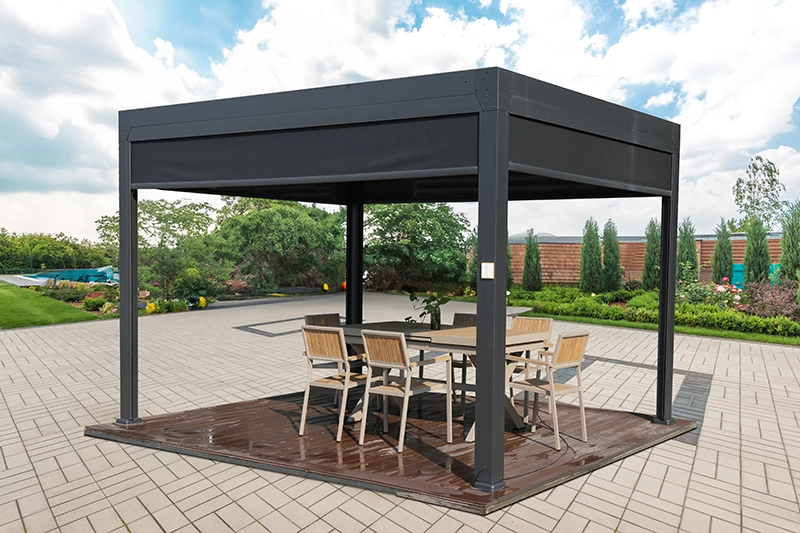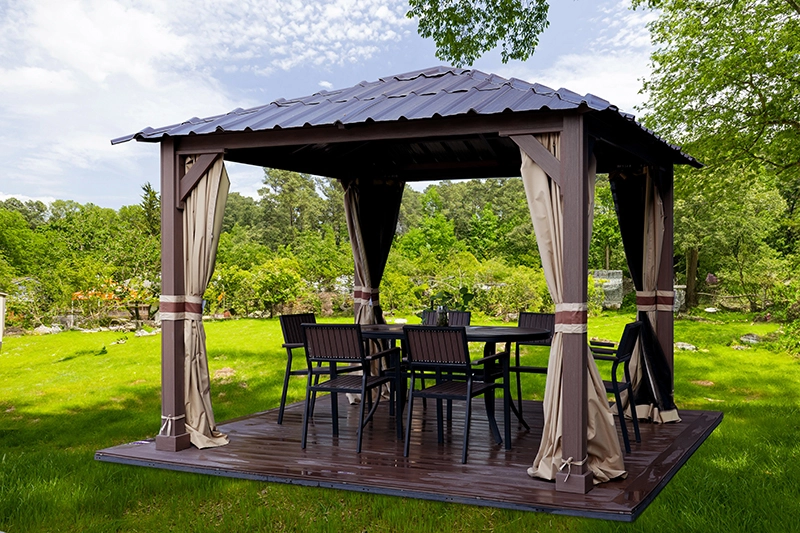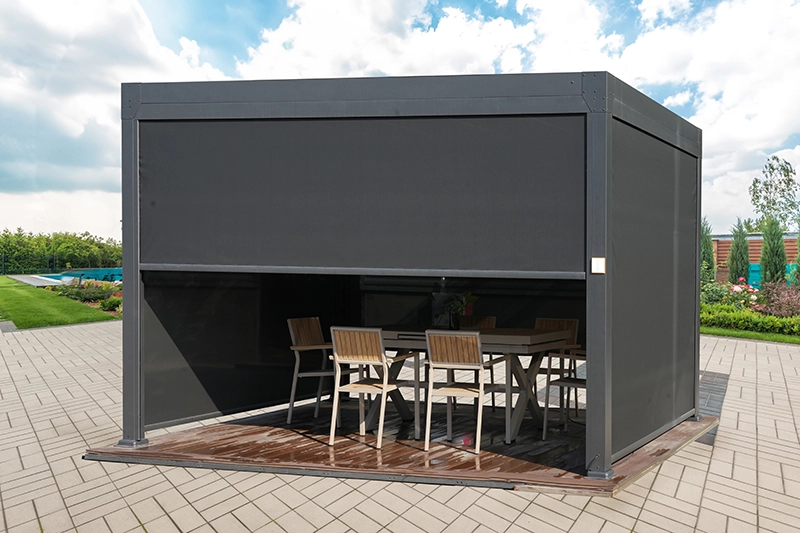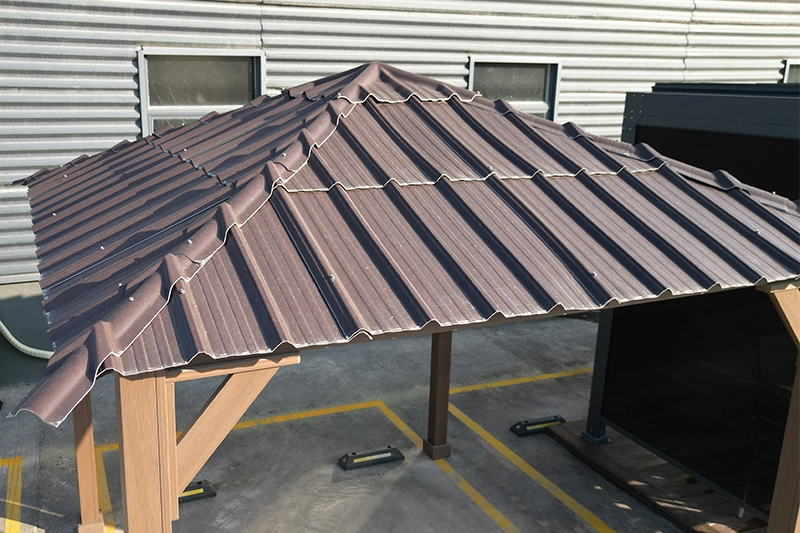Outdoor structures like gazebos and pergolas are popular additions to gardens and backyards, providing aesthetic appeal and functional space for relaxation and entertainment. Understanding the differences between these two structures can help homeowners make informed decisions about which one best suits their needs. This article will explore the characteristics, benefits, and considerations of both gazebos and pergolas, providing a comprehensive comparison.
Understanding Gazebos
Definition and Structure
A gazebo is a freestanding outdoor structure, typically octagonal or hexagonal in shape, with a solid roof and open sides. This design allows for a sheltered area that can be used for various purposes, such as dining, entertaining, or simply enjoying the outdoors. Gazebos are often constructed from wood, vinyl, or metal, and they can be adorned with decorative elements like railings, latticework, and built-in seating. The architectural style of a gazebo can vary widely, from traditional designs featuring intricate woodwork to modern interpretations with sleek lines and minimalist aesthetics. This versatility in design allows homeowners to choose a gazebo that complements their existing landscape and home architecture.
Benefits of Gazebos
Gazebos offer several advantages that make them a desirable choice for many homeowners:
Protection from the Elements: The solid roof of a gazebo provides excellent protection from rain, sun, and wind, allowing for comfortable outdoor use in various weather conditions. This feature is particularly beneficial for those who enjoy hosting outdoor gatherings, as it ensures that guests can remain sheltered regardless of the weather.
Privacy: Many gazebos feature walls or screens that can enhance privacy, making them ideal for intimate gatherings or quiet retreats. This added privacy can create a cozy atmosphere, allowing families to enjoy their outdoor space without feeling exposed to neighbors or passersby.
Aesthetic Appeal: Gazebos can serve as a focal point in a garden or yard, adding charm and character to the landscape. They can be customized to match the architectural style of the home, whether it be rustic, contemporary, or classic. The addition of decorative elements such as lighting, furniture, and plants can further enhance their visual appeal.
Increased Property Value: A well-constructed gazebo can enhance the overall value of a property, making it an attractive feature for potential buyers. As outdoor living spaces become increasingly popular, having a gazebo can set a home apart in the real estate market, appealing to buyers looking for functional and beautiful outdoor areas.

Considerations for Gazebos
While gazebos have many benefits, there are also some considerations to keep in mind:
Cost: Gazebos tend to be more expensive than pergolas due to their solid construction and materials. Homeowners should budget accordingly, considering not only the initial cost of the gazebo but also any additional expenses for installation and maintenance.
Space Requirements: Gazebos require a larger footprint than pergolas, which may limit placement options in smaller yards. Homeowners should assess their outdoor space to ensure that a gazebo will fit comfortably without overwhelming the landscape.
Maintenance: Depending on the materials used, gazebos may require regular maintenance, such as painting or sealing, to keep them in good condition. Wood gazebos, in particular, may need to be treated periodically to prevent rot and insect damage, while vinyl and metal options may require less upkeep.
Understanding Pergolas
Definition and Structure
A pergola is an outdoor structure characterized by a framework of vertical posts or pillars that support crossbeams and an open lattice roof. Unlike gazebos, pergolas do not have solid roofs, allowing sunlight to filter through while providing partial shade. They are often used to create pathways, passageways, or as a decorative element in gardens. The open design of a pergola encourages the growth of climbing plants, which can weave through the lattice and create a natural canopy, enhancing the beauty of the structure and the surrounding area.
Benefits of Pergolas
Pergolas offer a unique set of advantages that appeal to many homeowners:
Versatility: Pergolas can be used in various ways, such as creating outdoor dining areas, seating spaces, or pathways. They can also support climbing plants, adding greenery and beauty to the structure. This versatility allows homeowners to adapt the pergola to their specific needs, whether for entertaining guests or creating a tranquil retreat.
Cost-Effective: Generally, pergolas are less expensive to build than gazebos, making them a budget-friendly option for enhancing outdoor spaces. The simpler construction and materials often lead to lower overall costs, allowing homeowners to invest in additional landscaping or outdoor furniture.
Open Design: The open design of a pergola allows for better airflow and light, making it a great choice for warmer climates where shade is desired without complete enclosure. This feature can create a more inviting atmosphere, encouraging outdoor living and relaxation.
Easy Installation: Pergolas are often easier and quicker to install than gazebos, which can be beneficial for homeowners looking for a DIY project. Many pergola kits are available on the market, providing all the necessary materials and instructions for a straightforward assembly process.

Considerations for Pergolas
While pergolas have many benefits, there are also some factors to consider:
Limited Protection: The open roof design of a pergola provides less protection from rain and sun compared to a gazebo. Homeowners may need to add additional features, such as retractable canopies or outdoor curtains, for more coverage. This consideration is particularly important for those who live in areas with unpredictable weather.
Less Privacy: Pergolas typically offer less privacy than gazebos, as they do not have solid walls. This may be a consideration for those looking for a secluded outdoor space. Homeowners can enhance privacy by incorporating climbing plants or drapes, but this may require additional planning and maintenance.
Maintenance of Climbing Plants: If homeowners choose to grow climbing plants on their pergola, they will need to manage the growth and maintenance of these plants to prevent damage to the structure. Regular pruning and care are essential to ensure that the plants do not become overgrown or invasive.
Comparing Gazebos and Pergolas
Design and Aesthetics
When it comes to design, gazebos and pergolas offer distinct aesthetics. Gazebos are often more ornate and can serve as a focal point in a garden, while pergolas provide a more open and airy feel. The choice between the two will depend on personal preference and the overall style of the outdoor space. Homeowners should consider how each structure will complement their existing landscaping and home architecture, as well as their personal style.
Functionality
Both structures serve different functional purposes. Gazebos are ideal for creating sheltered areas for gatherings, while pergolas are better suited for enhancing outdoor pathways or providing partial shade. Homeowners should consider how they plan to use the space when choosing between the two. For example, if the primary goal is to create a space for dining and entertaining, a gazebo may be the better choice. Conversely, if the goal is to create a beautiful garden feature that supports climbing plants, a pergola may be more suitable.

Cost Considerations
Cost is a significant factor for many homeowners. Gazebos generally require a larger investment due to their solid construction and materials. Pergolas, on the other hand, are often more budget-friendly and can be customized to fit various price points. Homeowners should evaluate their budget and consider the long-term value of each structure, including potential increases in property value and the enjoyment they will bring.
Installation and Maintenance
Installation and maintenance requirements differ between the two structures. Gazebos may require professional installation and ongoing maintenance, while pergolas can often be installed as a DIY project with less upkeep. Homeowners should assess their skills and willingness to maintain the structure over time, as this can influence their decision.
Conclusion
In conclusion, both gazebos and pergolas offer unique benefits and considerations for homeowners looking to enhance their outdoor spaces. Gazebos provide excellent protection from the elements and privacy, making them ideal for sheltered gatherings. Pergolas, with their open design and versatility, are perfect for creating inviting outdoor areas that allow for sunlight and airflow.
Ultimately, the choice between a gazebo and a pergola will depend on individual preferences, budget, and intended use. By understanding the differences and benefits of each structure, homeowners can make informed decisions that will enhance their outdoor living experience for years to come. Whether opting for the solid shelter of a gazebo or the airy elegance of a pergola, both structures can significantly enrich the enjoyment of outdoor spaces.

Frequently Asked Questions regarding Outdoor Structures
1. What is the primary difference between a gazebo and a pergola?
The primary difference lies in their structure and purpose. A gazebo is a freestanding structure with a solid roof and open sides, providing shelter from the elements. In contrast, a pergola consists of vertical posts supporting a lattice roof, offering partial shade while allowing sunlight to filter through.
2. Can I use a gazebo for outdoor dining?
Yes, gazebos are excellent for outdoor dining as they provide protection from rain and sun, creating a comfortable environment for meals and gatherings. Many gazebos can be equipped with furniture, lighting, and even outdoor kitchens to enhance the dining experience.
3. Are pergolas suitable for climbing plants?
Yes, pergolas are ideal for supporting climbing plants. The open lattice design allows vines and other plants to grow through, creating a beautiful natural canopy. Homeowners often use pergolas to enhance their gardens with greenery and flowers.
4. How much maintenance do gazebos and pergolas require?
Gazebos typically require more maintenance than pergolas, especially if made of wood, as they may need regular painting or sealing to prevent rot and damage. Pergolas, depending on the material, may require less upkeep, but if they support climbing plants, regular pruning and care will be necessary.
5. What factors should I consider when choosing between a gazebo and a pergola?
When choosing between a gazebo and a pergola, consider factors such as your budget, the intended use of the structure, the available space in your yard, and the level of maintenance you are willing to commit to. Additionally, think about the aesthetic appeal and how each structure will complement your home and landscape.





